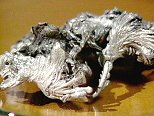 Discovery Information Discovery Information
|
| Who: Fredrich Stromeyer |
| When: 1817 |
| Where: Germany |
|
 Name Origin Name Origin
|
| Greek: kadmeia (ancient name for calamine (ZnCO3)); Latin: cadmia.
|
| "Cadmium" in different languages. |
|
 Sources Sources
|
| Obtained as a by product of zinc refining. Occurs in rare ores such as Greenockite (CdS), the only mineral cadmium of any importance.
|
| Annual production is around 14 thousand tons. |
|
 Abundance Abundance
|
| Universe: 0.002 ppm (by weight) |
| Sun: 0.006 ppm (by weight) |
| Carbonaceous meteorite: 0.45 ppm |
| Earth's Crust: 0.11 ppm |
| Seawater: |
| Atlantic surface: 1.1 x 10-6 ppm
|
| Atlantic deep: 3.8 x 10-5 ppm
|
| Pacific surface: 1.1 x 10-6 ppm
|
| Pacific deep: 1 x 10-4 ppm
|
| Human: |
| 700 ppb by weight |
| 39 ppb by atoms |
|
 Uses Uses
|
| Used in nickel-cadmium batteries (about 75% of all cadmium is used in batteries), nuclear reactor regulator, bearing alloys, solder and red/yellow pigments.
|
| Compounds containing cadmium are used in black and white television phosphors and also in the blue and green phosphors for colour television
picture tubes.
|
| Used in some semiconductors such as cadmium sulfide (CdS), cadmium selenide (CdSe), and cadmium telluride (CdTe), which can be used for light detection or solar cells. Mercury cadmium telluride (HgCdTe) is sensitive to infrared.
|
| Cadmium forms various salts, with cadmium sulfide (CdS) being the most common. This sulfide is used as a yellow pigment. Cadmium selenide (CdSe) can be used as red pigment, commonly called cadmium red.
|
|
 History History
|
| Cadmium (Latin cadmia, Greek kadmeia meaning "calamine") was discovered in Germany in 1817 by Friedrich Strohmeyer. Strohmeyer found the new element within an impurity in zinc carbonate (calamine) and for
100 years Germany remained the only important producer of the metal. The metal was named after the Latin word for calamine
since the metal was found in this zinc compound. Strohmeyer noted that some impure samples of calamine changed colour when heated but pure calamine did not.
|
| Even though cadmium and its compounds are highly toxic, the British Pharmaceutical Codex from 1907 states that cadmium iodide
was used as a medicine to treat "enlarged joints, scrofulous glands, and chilblains".
|
|
 Notes Notes
|
| Cadmium is a soft ductile metal that can easily be cut with a knife. |
|
 Hazards Hazards
|
| Cadmium is extremely poisonous, even in low concentrations. Many cadmium compounds are believed to be carcinogenic. |
| Cadmium is harmful to aquatic organisms and water treatment plants. |





 Discovery Information
Discovery Information
 Name Origin
Name Origin
 Sources
Sources
 Abundance
Abundance
 Uses
Uses
 History
History
 Notes
Notes
 Hazards
Hazards
 Images
Images


